If you’re beginning to record music professionally, you have heard about all the gear you should buy. And an audio interface is most likely on the top of your list. But what exactly is an audio interface, and why is it so important?
An audio interface is an external sound drive that converts sound waves into a computer-readable format and back into sound waves. It lets you connect different audio gear to your computer and record them simultaneously, including professional microphones, musical instruments, and amplifiers.
This article will tell you everything you need to know about audio interfaces and what they do. I’ll talk about the different inputs and outputs and other critical features of an interface. I’ll also describe what to look for when buying your first audio interface.
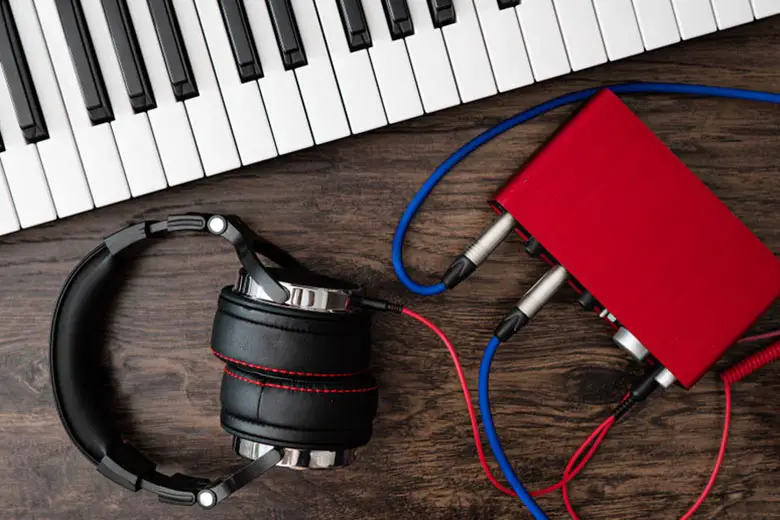
What Is an Audio Interface?
An audio interface is an essential component of music and sound production at any level. It lets you connect multiple microphones and audio sources to your computer so that everything is recorded simultaneously and with good sound quality.
If you want to record more than one track at a time, you need an audio interface.
There are audio interfaces with just two sound inputs and outputs and some with up to thirty or more.
These mixing channels do what an old-fashioned mixing desk did—bring all of the sounds in a recording together to make them sound coherent and balanced. It does this with analog/digital converters built into both the computer and audio interface.
Most audio interfaces connect directly to the computer via a USB port. Older models may come with Thunderbolt or Firewire ports, but these can be adapted for USB use. The majority of interfaces are easy to use, not too expensive, and accessible for new music producers.
Also Read: Audio Interface vs. Mixer: Which Is Right for You?
What Does an Audio Interface Do?
An external audio interface allows you to record more than one audio input simultaneously, only limited by how many inputs the machine has.
It translates the sounds from your microphone into a digital format that your computer can understand.
Once you’re ready to listen to the recording, it then translates the digital format back into the sounds you hear.
An interface does this by taking the analog sounds (singing, instruments, speaking) and converting them into binary code that the computer can interpret. The analog to digital converter also works the other way around, translating what’s recorded into the computer back into sounds.
Why Do You Need an Audio Interface?
Simply put, an audio interface does what your computer already does but does it better. If you have a computer, you already have a small interface in your built-in sound system. You can record and replay your recordings. If this is enough for you, you don’t need an audio interface.
However, if you’re serious about sound production or music recording, you need an audio interface.
That’s because the computer’s built-in interface isn’t designed to handle complex recording scenarios.
Even people who have a USB microphone often decide to invest in an audio interface. A good USB microphone will do wonders for vocal quality.
Still, if you want to record instruments, more than one microphone, or over multiple monitors, you’ll need an audio interface.
In addition to recording more than one source simultaneously, interfaces support different types of microphones, such as XLR mics. They also make volume control and mixing easier. The more high-end your audio interface is, the more options it will have for extra mixing and volume options.
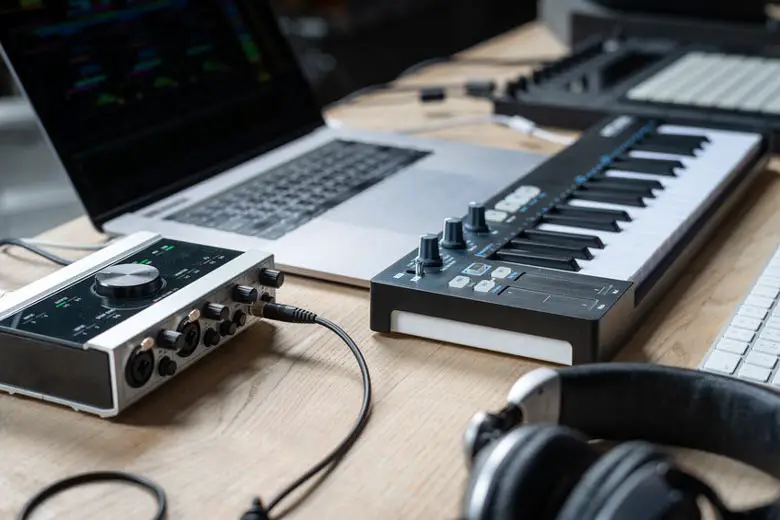
High-Quality Vocal Recording
Even if you are only recording one voice, an interface will help your sound quality increase. A good interface takes care of background noise and singles out and amplifies the leading voice.
Microphone quality is important in tandem with an interface. For professional vocal recording, whether solo or with other instruments, an audio interface hooked up to a high-quality microphone will give you the best sound and playback.
That’s why an audio interface is one of the things you need to start a podcast, for example.
Recording With Multiple Microphones
If you’re recording more than one voice, you need an audio interface. While two people can sing or speak into one microphone simultaneously, it’s nearly impossible for the two voices to be correctly balanced.
One person will always be louder or closer to the mic, making editing and mixing harder.
However, with an audio interface, you can hook up as many microphones as you have audio inputs. These can record simultaneously or separately, but you’ll have no trouble mixing or recording them since they’re on different audio tracks.
It is infinitely easier to record multiple tracks at once than recording each channel separately, editing them together later, and providing a better result.
Recording Instruments
Audio interfaces aren’t just a convenience; they’re essential for recording instruments. While you can record acoustic instruments with just a microphone, you need a plug-in for electronic keyboards, guitars, drum sets, or any other electric instrument.
Without an audio interface, it’s impossible to make recordings with instruments accurately.
An entire band of instruments can record a song with a large enough interface. The preamps will ensure no single device gets drowned out; the editing and mixing process will even out the recorded sounds.
It is possible to connect a mixer to an audio interface and record the combined audio channels in stereo if you would like to as well.
Recommended article: Here’s How You Can Get Studio Quality Sound at Home
What Are the Features of an Audio Interface?
There are hundreds of different audio interfaces on the market, with their unique features. The number of inputs and outputs varies by size and style, but most interfaces come with at least two inputs and two outputs.
There are also special capabilities to consider.
Inputs
Audio inputs are the essential part of an audio interface; they’re what brings the sound from the microphone into the computer system. Standard inputs include a microphone input, MIDI input (usually used for keyboards), and a direct line input for electric guitars and basses.
There are also specialty inputs for specific uses or instruments. Here are some of the most common types of inputs and what instruments use them:
- Microphones use XLR inputs
- Guitars use Hi-Z inputs
- Amplifiers and other instruments use ¼” (direct line) inputs
- Electrical connectors use DB-25 inputs and outputs
- Keyboards and synthesizers use MIDI inputs
- Specialty pedals use MIDIs
Recommended reading: 11 Cables You May Need for an Audio Interface
It’s also helpful to have multiple of the same input if you’re using more than one instrument of the same type. The larger your band is, the more inputs you’ll need – many interfaces come with up to thirty inputs and outputs for recording large groups.
Outputs
An output is what brings the music from the computer or interface so that you can hear it. There are generally fewer outputs than inputs since the final recording often contains multiple channels.
This is useful not only for recording but also for live shows and band sessions.
Standard outputs include:
- Computer connection (USB, Firewire, or Thunderbolt)
- Headphone jack
- MIDI output for keyboard or amplifier
- S/PDIF outputs for home theatres
- DB-25 outputs for electrical connectors
- ADAT S/MUX outputs for surround sound
Also Read: Should You Plug Headphones Directly Into Audio Interface?
Outputs are either balanced or unbalanced. A balanced output uses three conductors to carry the sound: positive, negative, and ground (neutral).
Unbalanced outputs combine the negative conductor with the neutral. This saves space but can reduce the audio quality for more complicated instruments.
It’s better to have a balanced (XLR) output than an unbalanced (TRS) because the computer gets two copies of the sound and can avoid the “ground loop” issue (which causes excess noise).
Microphones use balanced outputs for the best sound quality. Unbalanced outputs can be helpful and work well with single-stream instruments such as electric guitars.
Other than the computer connection, the most common output is the headphone jack or amplifier output. Every interface will have these, and therefore, an audio interface can be used as a headphone amp.
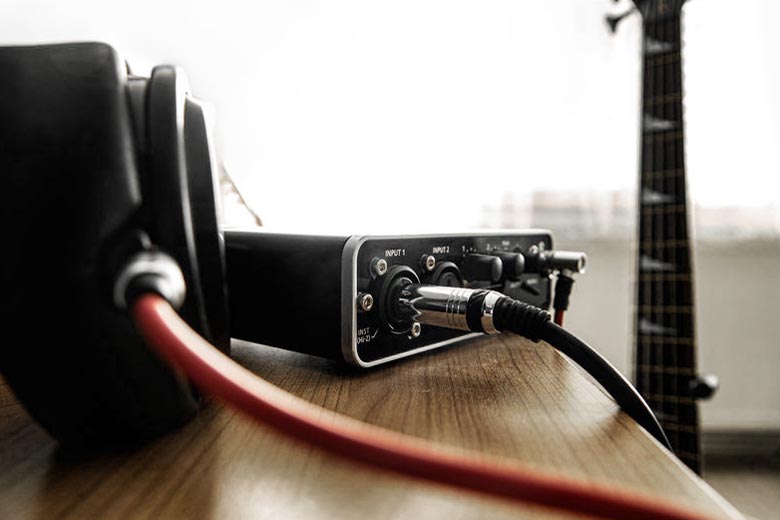
Preamps
Preamps are another vital part of audio interfaces. Pre-amplifiers are different from regular amplifiers. Regular amps push the audio input volume up after being recorded (or while it’s being played).
You can use power amps to increase the overall sound or volume on a specific track. A preamp will bring weak volume to the next level while it’s being recorded.
Instead of adjusting the sound after, a preamp helps the input be at the same level as everything else.
Preamps are how the audio interface picks up sound through the microphone and are installed in every interface.
It’s important to remember that bringing your audio up a gain stage, even with a preamp, will add some background noise. If you want high-quality audio without adding any noise, the best option is to buy a high-quality microphone.
Microphones are the most significant factor in sound quality. All interfaces have preamps – you can opt for different levels of sound amplification and volume.
Converters
Converters are the components that translate analog waves into binary and back again. Every audio interface comes with a set of converters, but you can also buy them separately.
Converters work by measuring the height of the sound wave coming in and converting it from its original analog audio signal into a digital sound that a computer can process.
When converting from analog to digital, a converter takes a measurement of the sound wave at steady intervals. The distance between these measurements is called the sample rate – the higher the sample rate, the more measurements are taken, and the better the audio quality is.
Word Clock
The word clock is an essential feature on audio interfaces, especially for multiple-track recordings. It sends a signal to synchronize all of the devices connected to the interface itself.
It’s also sometimes referred to as the sample clock (which is slightly different, as it synchronizes the time between samples instead of the devices).
Almost every audio interface will have a word clock.
Unless the interface only has one or two inputs, it’ll need a word clock to sync everything up and make sure the digital audio signals match.
You can turn it on and off, but the digital master clock helps audio data transmission.
MIDI
A MIDI input and output is one of the most common features of an audio interface. While it’s technically an input/output device, it does many unique things for sound quality and connection.
MIDI stands for Musical Instrument Digital Interface and does for instruments what the audio interface does for sound in general.
MIDIs were created to make the technical language of music universal – no matter where the instrument was made or what the connectors are, a MIDI output will connect different technologies.
The MIDI input only transfers information but has no way of making sound on its own. While it’s a vital part of the transference of music from instruments (usually keyboards or synthesizers), it is only one music recording component.
Several different brands of electronic instruments use a MIDI input to connect to an interface. Specialty pedals (such as loop pedals or echo pedals) also use MIDI, so it’s an essential piece of technology for many musicians and recorders.
Zero-Latency Monitoring
Latency is a common issue with monitors and microphones. Sometimes while recording, there is a lag between the sound and the playback. This is called latency and can make it difficult to synchronize instruments with the voice or re-record accurately.
There are ways to reduce latency post-recording, but as with sound quality, it’s easier to do it before or during the recording process.
If your interface has an option for zero-latency monitoring, you will be able to record without worrying about latency or sound delay.
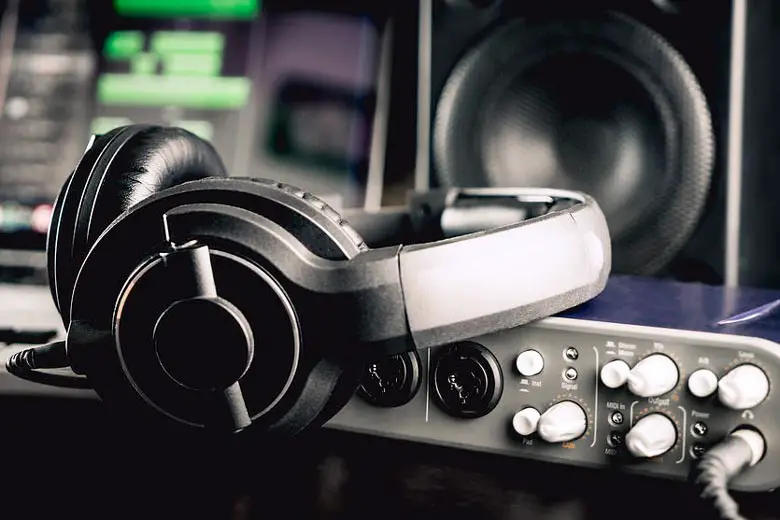
Audio interfaces achieve zero latency by rerouting the audio from the computer directly to the audio output. Instead of traveling through the computer and creating a sound delay, the audio comes directly back through the monitors and can be heard immediately.
A monitor will prevent almost all latency. If you find an audio interface with a monitor, you’ll use it for directing monitoring. You can also buy a separate monitor control and set it up with your interface. Whether it is a blend control, a switch, or a DSP mixer, monitoring will help raise your audio and recording quality.
Monitoring can reduce latency and help the recording musicians hear their music in real-time. Direct monitoring isn’t usually part of an audio interface but is a separate monitor that can work with interfaces.
While many interfaces are not precisely synchronized with the sound, this will reduce the lag. You can use recording and editing software to get rid of the rest.
Phantom Power
Phantom power is designed to use the sound input to give the microphone power. The power comes through the mic cables themselves instead of the regular power source.
It does this by taking the sound’s vibrations and bouncing them back and forth between the microphone and mesh covering. It helps save energy on the microphone, but the vibrations have to be amplified before leaving the mic.
If you have a condenser microphone and want to use it with your audio interface, you’ll need an audio interface with +48V phantom power accessibility.
Most audio interfaces are phantom power accessible, but it’s essential to make sure.
Related article: Do Wireless Mics Need Phantom Power?
Buying an Audio Interface
Besides having many more inputs and outputs, professional interfaces have unique settings and dials to increase sound quality or mix the tracks on the interface itself.
Every audio interface has a different setup, and it’s essential to know which one works best for you. If you’re considering buying an audio interface, do your research beforehand and decide what is best for your recording needs and budget.
It’s also important to know about your laptop’s compatibility with your interface; most are PC and Mac compatible, but there are a few that only work one way.
What To Look For in an Audio Interface
The audio interface you buy will be an essential part of your music and vocal recording. Before you buy it, you want to be sure you are purchasing one that will fit your needs.
You want to look at the connections, the quality of preamps and converters, the number of inputs and outputs, and any additional features you need.
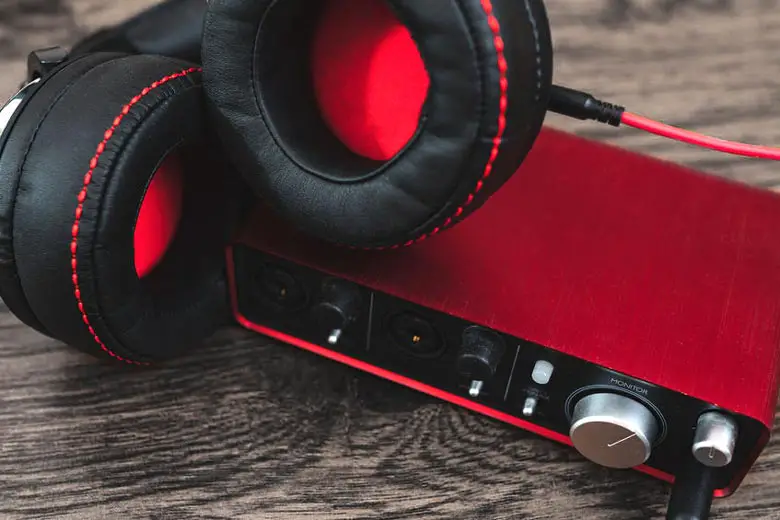
There are several sizes and types of audio interfaces. You’ll have to look at your budget, what you’re trying to record, and how you’re planning on recording it. Once you’ve decided what kinds of inputs, specs, and settings you need, you can start looking at specific interfaces.
Input and Output Configuration
At the bare minimum, you need at least two inputs and one output on your interface. Most audio interfaces don’t come with less than that. For a larger band or group of musicians, you will want a larger interface.
Singer-songwriters and individual vocalists would do well with a smaller audio interface, but anyone doing more than a few tracks will need more microphone inputs and more outputs.
For a full band or anything electronic, you may need an audio interface with eight inputs, and they should all come with preamps.
MIDI and Hi-Z inputs and outputs are necessary for electric instruments. A MIDI is also helpful for any special effects pedals, such as loop pedals or DI boxes. Boxes and pedals will distort, repeat, or modify the music while you are recording it.
They can also be used for live shows, but you’ll need an audio interface with multiple MIDI inputs and an amplifier output.
Related article: Does a DI Box Really Reduce Noise?
Sample Rate and Bit Depth
The technical specifications on audio interfaces are hard to understand and can be overwhelming. However, the basics are pretty straightforward: you want a higher bit depth (usually 24-bit) and a sample rate of 44.1 kHz or higher.
If you’re a beginner, anything with these specs will be perfect for your recordings.
The sample rate varies depending on the frequency of the converter. If the converter measures the sound wave more, the rate is higher. 44.1 kHz per second is the standard CD rate, so most of the things you record will be just fine.
Some professionals like to use rates of up to 96 kHz or more, but 44.1 is high enough since the human ear can’t perceive higher frequencies.
The bit rate measures the data being recorded into the audio. The higher the bit rate, the more smoothly the audio signal will go through, and the better the sound will be. With a low bit rate (16-bit or below), the dynamics levels will be less varied, and the quieter parts of the audio will have more static.
Preamps
Every interface will come with preamps on most of their input signals. However, you can buy an interface with more or fewer preamps, depending on your needs.
Preamps will keep your vocals or instruments at a higher level and reduce background noise. It’s also possible to have preamps installed within your instrument itself, but you will still need one to record with your interface.

Computer Connectivity
USB connection is the standard for interfaces, but some fancier ones will come with Firewire or Thunderbolt. For more professional uses, you might want one of these two. However, if you only have a USB port, you can buy a converter or just a USB connective interface.
Thunderbolt is the highest quality connection. It has almost no latency and incredibly high speeds, so professional musicians and recorders prefer it.
Firewire is a little faster than USB and more consistent over multiple recording tracks. If you don’t have these ports on your computer, you can purchase an adaptor.
Also Read: 10 Reasons Your Audio Interface Keeps Dropping Out
Cost
A limiting factor in purchasing the audio interface you want can be price. While they aren’t always cheap, there are some affordable options for interfaces.
You can find simple, two or three input USB interfaces between $100 and $300. These are the best options for beginners.
Of course, there are more expensive options. If you want an interface with multiple inputs and outputs and the best latency monitoring, you might end up paying as much as $1,500 or more. Thunderbolt and Firewire enabled interfaces also sell for more, but most USB interfaces are cheaper.
Best Audio Interfaces
Audio interfaces can be a little overwhelming to research and buy, especially if you’re just beginning. With variety for price, input needs, and audio recording capabilities, here are some of the most popular interfaces selling today.
You might also want to read our article ‘Do Audio Interfaces Affect Sound Quality?’.
Audient ID4

Audient offers one of the best interfaces for beginning sound producers with smaller budgets. The ID4 has two inputs and two outputs, making it one of the simplest interfaces available. However, it can record great quality sound for one of the lowest prices on the interface market.
The Audient ID4 is easy to use, with large knobs to adjust settings and a USB connection. It can also be used with an iPhone or iPad, depending on the connectivity package you purchase with the device.
For the money, this interface is a great starter choice for beginners with several different options.
Focusrite Scarlett 4i4

Focusrite Scarlett offers a high-quality audio interface at a much lower price than many of its competitors. It’s a simpler interface than some of the more expensive items, with only four inputs and outputs. However, it has MIDI capabilities and high-quality preamps for great sound.
Focusrite has several models, but the 4i4 is its latest version, with two mic inputs for a greater variety of recording ability.
If you buy the interface and download the app, you’ll be able to use the software to change settings on the interface and use extra effects like zero-latency monitoring.
Universal Audio Apollo

One of the most popular audio interfaces available, the Audio Apollo has some of the best sounds for its size. It’s simple to look at and to use, plugs directly into the wall for power, and can raise your audio quality to a professional level with one use.
Universal’s Audio Apollo interface is unique in that it offers a combination of both hardware and software in a small, desktop package. When you connect it to your computer, you’ll be able to look at the audio you’ve recorded and adjust the settings.
It only has a Thunderbolt connection but is worth the price of a converter for the amount of sound it provides.
Arturia Audiofuse

The Arturia Audiofuse is a small but powerful interface with many options for connectivity and instrument recording. It has MIDI capabilities, several different input/output styles, and two separate headphone jacks. There are also several extra USB ports – a huge bonus if you record with multiple USB microphones.
The Audiofuse delivers and was made for excellent sound quality. The connections and design help the interface to work well and do its job. It’s got a great sound for such a small interface, but the real star is the connectivity.
Antelope Audio Zen Tour Synergy Core

The Antelope audio interface is one of the more expensive but will offer everything you need in an interface.
With zero-latency monitoring and a huge bundle of special effects, the interface is a great choice for serious music producers and recorders. It’s not hard to use and will fit on a desk.
If you are a professional musician and are looking for the highest quality audio interface with no concern for price, consider the latest antelope model. It has multiple inputs and outputs with the latest upgrades in audio systems.
Final Thoughts
Audio interfaces are the necessary connection between your voice and your computer. They convert the analog sound waves into digital audio.
Without them, everything that you want to record and mix wouldn’t happen. Interfaces vary by settings, inputs and outputs, and size – it’s important to know what you need before buying one.